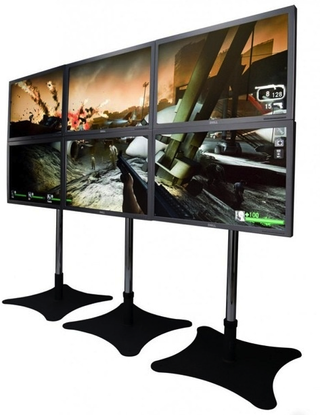AMD's Eyefinity Technology Explained

En Route To The Holodeck
Major changes to the PC graphics experience come few and far in between. Perhaps the last significant update was the move to multi-GPU rendering, a la ATI CrossFire. Of course, despite the well-known performance benefits of employing multiple GPUs, the technology has some obvious drawbacks. More than one motherboard slot is usually required for multi-GPU configurations, which in turn means that you wind up consuming two or more cards worth of power, rather than just one.
On the application front, you're free to span a desktop across multiple screens, running multiple apps across one or more displays concurrently. However, traditionally, spanning an application across more than one screen meant that it had to be non-accelerated. You could have size or you could have speed, but you couldn’t have both.

Times have changed. AMD’s new Eyefinity technology takes us to the next level in mainstream multi-monitor output. Known as “SunSpot” to only a handful within AMD up until its launch day, Eyefinity enables up to six monitors to be controlled from one card, enabling a massive “surface” area exceeding 24 megapixels. If you read AMD’s literature on Eyefinity, it says that “we are inexorably on the road to the ‘holodeck’ (as conceptualized on Star Trek).” Given that the Star Trek holodeck involved haptics (tactile feedback) based on force fields and such, this might be a tad hyperbolic. A better, if less-known, analogy might be the CAVE (Cave Automatic Virtual Environment), a small chamber comprised of three to six screens showing rear-mounted 3D projections. Dozens of universities use CAVE systems for research around the world, so imagining a consumer version of CAVE enabled by AMD’s technology isn’t at all far-fetched. If you’ve read Fahrenheit 451 and recall the three-walled, immersive home entertainment systems Bradbury imagined, that’s where Eyefinity (with a little help from ultra-high-speed broadband) is headed.
If your primary PC is a single-screen notebook, the thought of having six monitors may seem overwhelming and excessive. So let’s be clear at the outset: Eyefinity is a means, not an end. If CrossFire was ATI/AMD’s method for helping consumers go multi-GPU, then Eyefinity is the next evolution of that. The object is not to pile on as many screens as possible. Rather, the object is to make computing “surfaces,” the real estate on which you visualize a computer-generated environment, as scalable as possible.
Today, DisplayPort is a key piece in making that scalability happen, as is a redesign in how multi-monitor computing happens on the video card. Let’s dig in and see what Eyefinity really is and does.

Stay On the Cutting Edge: Get the Tom's Hardware Newsletter
Get Tom's Hardware's best news and in-depth reviews, straight to your inbox.
-
mooch37 @sykar My thoughts exactly. It has to be an odd number of monitors, otherwise you'll get the crosshair right in the middle. That would bug the crap out of me.Reply -
drowned "In assessing single- versus dual-monitor (18" LCDs) usage in everyday work environment applications"Reply
The key word in your statement is DUAL monitors. I recall another study that tested how much people prefer 3 or 4 monitors over 2, and it was a very small percent (~10%). For a lot of tasks outside of gaming, you don't want your entire vision filled with pixels. You don't want to get dizzy constantly from moving your head back and forth. Of course eyefinity is great if you want to blow a ton of money for a wall of monitors and your career is a stock trader, CERN mission controller, etc, but I'd rather stick with 3 physical and use virtual desktops for 3+. -
Trueno07 It all made sense to me, until I saw the picture of the kid playing a Racing game on that 6 monitor set up. It looked ridiculous. Why not just play on a big TV that has no lines and only requires 1 output?Reply -
Chris_TC Trueno07It all made sense to me, until I saw the picture of the kid playing a Racing game on that 6 monitor set up. It looked ridiculous. Why not just play on a big TV that has no lines and only requires 1 output?Absolutely, this one is quite ridiculous. Multiple displays only make sense for games if you sit closely and angle them. But the borders would still annoy the hell out of me.Reply
This may be a nice gimmick for some, but ultimately we'll be moving to curved screens. -
hackmule I used to use two monitors but since I went to three CRT monitors 5+ yrs ago I can't go back to two. This bezel in the middle is aggravating. I use three monitors for work - presentations/writing/graphics and the extra real estate is very valuable there. For play, I have been waiting for the hardware to improve to the point where 3 monitor frame rates are good enough and this eyefinity article has got me thinking that the new ATI cards might be worth a try. I think the next generation will be the game changer when three monitor play frame rates are over 50 for the games we like to play. I would be surprised if there are many who once they get used to three monitors would willingly go back to two.Reply -
falchard Big TV lacks the same resolution. Bezeless is hard to manufacture. I don't see the point in using Eye-finity in the method specified with multiple monitors in the front. I would rather setup like the Cave and Stereoscopic display. Borders wouldn't be much of an issue then. 4 x 55" display, 1 front, 1 on each side, and 1 above.Reply -
SmarterChoice Eyefinity is amazing with three screens, you don't notice the bezels at all in most games.Reply
